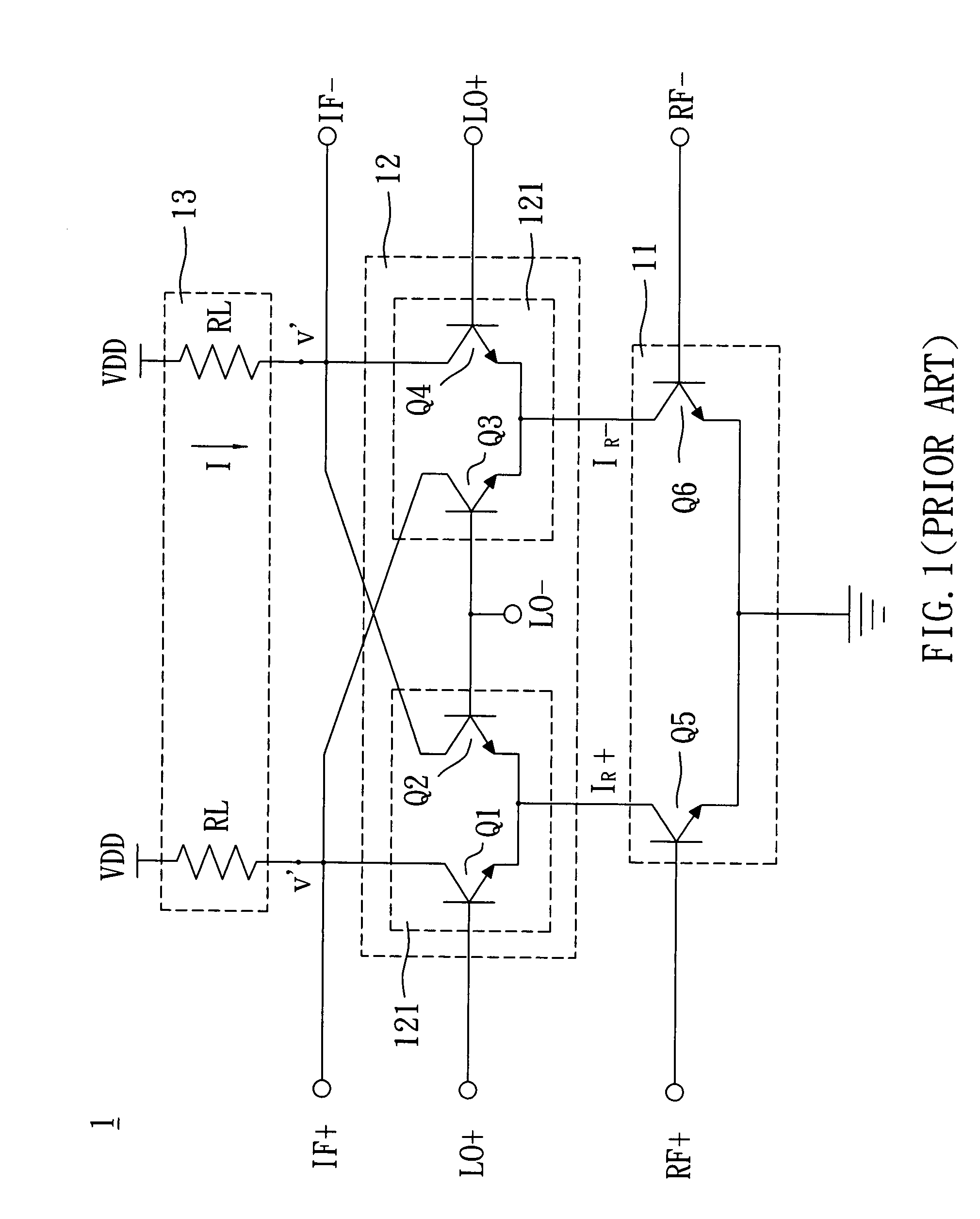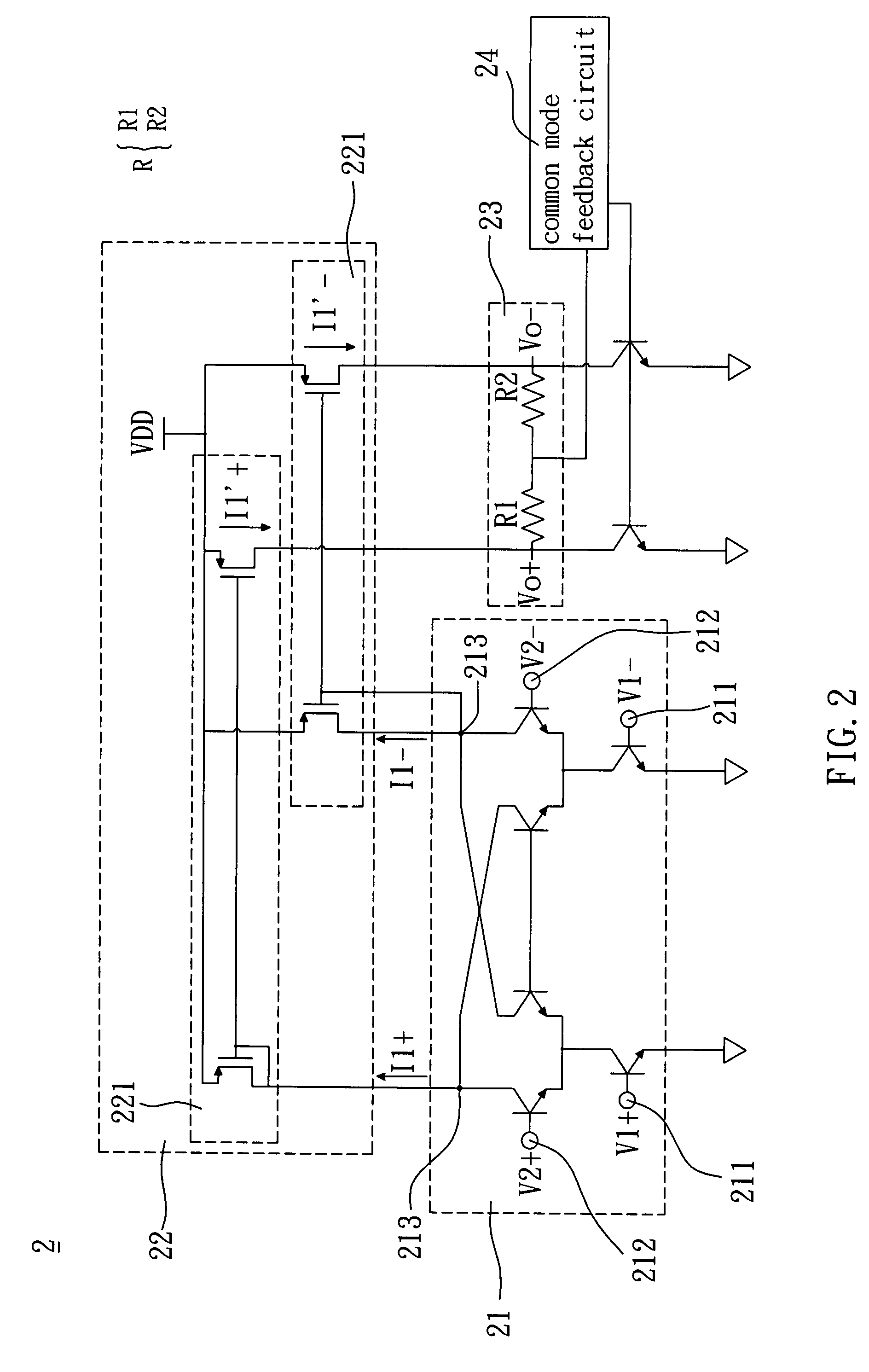Conversion mixer with high impedance circuit
a high-impedance circuit and conversion mixer technology, applied in the field of conversion mixers, can solve problems such as serious power consumption, and achieve the effects of avoiding the dead zone phenomenon, reducing the influence of the loading circuit on the couple of output signals, and extending the operation rang
- Summary
- Abstract
- Description
- Claims
- Application Information
AI Technical Summary
Benefits of technology
Problems solved by technology
Method used
Image
Examples
first embodiment
[0023]Referring to FIG. 2, a conversion mixer 2 according to the invention includes a mixing circuit 21, a duplicating circuit 22 and a loading circuit 23. The conversion mixer 2 of this embodiment may be a direct down-sampling conversion mixer.
[0024]The mixing circuit 21 of this embodiment includes a first differential input terminal 211, a second differential input terminal 212 and a differential output terminal 213. The first differential input terminal 211 and the second differential input terminal 212 respectively receive a couple of first input signals V1+ and V1− and a couple of second input signals V2+ and V2−. The mixing circuit 21 mixes the couple of first input signals V1+ and V1− with the couple of second input signals V2+ and V2− and thus outputs a couple of mixed signals I1+ and I1− from the differential output terminal 213. The couple of first input signals V1+ and V1− and the couple of second input signals V2+ and V2− are high-frequency signals, and the couple of mix...
second embodiment
[0030]In addition, referring to FIG. 3, a conversion mixer 3 according to the invention includes a mixing circuit 21, a duplicating circuit 22 and a loading circuit 23. The mixing circuit 21 receives a couple of first input signals V1+ and V1− and a couple of second input signals V2+ and V2−, and mixes the couple of first input signals V1+ and V1− with the couple of second input signals V2+ and V2− to output a couple of mixed signals I2+ and I2−. The duplicating circuit 22 coupled to the mixing circuit 21 receives the couple of mixed signals I2+ and I2−, and duplicates the couple of mixed signals I2+ and I2− to output a couple of duplicated signals I2′+ and I2′−. The loading circuit 23 coupled to the duplicating circuit 22 receives the couple of duplicated signals I2′+ and I2′−, and outputs a couple of output signals Vo+ and Vo− according to the couple of duplicated signals I2′+ and I2′−.
[0031]The conversion mixer 3 of this embodiment further includes a common mode feedback circuit ...
third embodiment
[0035]Referring to FIG. 4, a conversion mixer 4 according to the invention includes a mixing circuit 21, a duplicating circuit 22, a high impedance circuit 25, a loading circuit 23 and a common mode feedback circuit 24.
[0036]The mixing circuit 21 receives a couple of first input signals V1+ and V1− and a couple of second input signals V2+ and V2−, and mixes the couple of first input signals V1+ and V1− with the couple of second input signals V2+ and V2− to output a couple of mixed signals I3+ and I3−, which are small signal currents in practice. The high impedance circuit 25 coupled to the mixing circuit 21 and the duplicating circuit 22 guides the couple of mixed signals I3+ and I3− to be input to the duplicating circuit 22. In addition, the duplicating circuit 22 has to be coupled to the mixing circuit 21, receives the couple of mixed signals I3+ and I3− and duplicates the couple of mixed signals I3+ and I3− to output a couple of duplicated signals I3′+ and I3′−.
[0037]In this embo...
PUM
 Login to View More
Login to View More Abstract
Description
Claims
Application Information
 Login to View More
Login to View More - R&D
- Intellectual Property
- Life Sciences
- Materials
- Tech Scout
- Unparalleled Data Quality
- Higher Quality Content
- 60% Fewer Hallucinations
Browse by: Latest US Patents, China's latest patents, Technical Efficacy Thesaurus, Application Domain, Technology Topic, Popular Technical Reports.
© 2025 PatSnap. All rights reserved.Legal|Privacy policy|Modern Slavery Act Transparency Statement|Sitemap|About US| Contact US: help@patsnap.com



